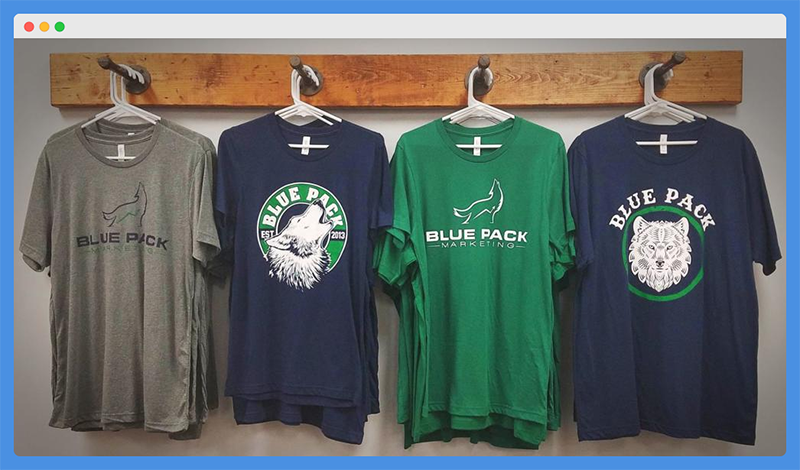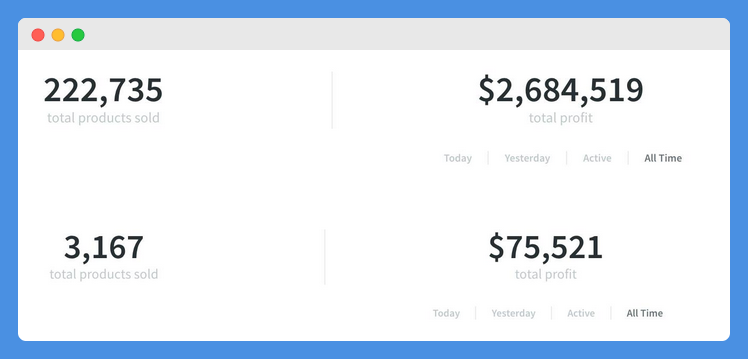
Have you ever looked at the clothing items like t-shirts, sweatshirts, leggings, and more on offer and thought you can do a much better job at it?
You probably even have an awesome idea, but you’re grappling with the possible risks that your wonderful ideas could crash and burn.
Not only that, but you’d be left broke with cartons of clothing in your garage that you were sure would fly off the shelves.
Teespring taps into the entrepreneurial spirit to offer budding fashionpreneurs and designers like you a chance to test the waters and only pay when people buy your t-shirts.
This way, the platform helps you start your t-shirt business and still keep things from going wrong.
Since 2012, the platform, which is part of the print on demand or on-demand commerce market, has been and still is making some of its sellers a fortune.
To date, over 19 million products have been sent to 180 countries, and Teespring claims to have made 30 millionaires and more than $300 million for its users.
Need proof? Here are some Teespring millionaires to inspire you.
Teespring Millionaires And Their Success Stories
1. Norlito Baclayen

Norlito Baclayen is touted as the Filipino who became the youngest Teespring millionaire.
His story begins from way back on campus when he struggled with hopelessness after realizing that he couldn’t continue with his university studies.
Born to a couple of farmers, Norlito and his family went through a rough patch, making it harder for his parents to afford to pay for his studies.
Not only that, but Norlito was still young and didn’t have any work experience, so he had to accept that he couldn’t get hired wherever he looked for a job.
The young man was lost and didn’t know how to get his life back on track. A few weeks after quitting his job search, Norlito came across a Teespring ad for a t-shirt on his Facebook newsfeed and decided he would venture into that business.
Norlito thought he could design something better and catchier than the shirt he saw on the Facebook ad.
When he clicked on the ad, he discovered that the shirts were selling like hotcakes and this sparked his curiosity.
He decided to explore the page and find out more about the shirt business. Surprisingly, he was instantly hooked and started to research this particular niche with the thinking that he could actually design better shirts and earn big.
Norlito created a Facebook page and through organic methods, he started to promote and grow the page.
He even followed other pages and joined groups in the same niche, and soon enough he had about 30,000 followers on his own page.
Unfortunately, even with his own tricks and Facebook ads, he couldn’t sell as many shirts as the page he found, and could only break even so he got frustrated.

On the brink of losing motivation or hope, Norlito woke up one morning and found his Facebook page had an overwhelming number of notifications.
One of his posts had gone viral overnight and from the 30,000 followers he had initially, the page grew to 80,000, 100,000, and hit more than 250,000 in a single night!
Plus, Norlito’s shirt purchases had gone from 10 to 50 shirts, and then to 100 shirts.
What transpired became Norlito’s blessing and he discovered that he was wrong to think that the idea was hopeless.
Excited by the overnight success of the viral design, Norlito gave his Facebook ads another try and managed to break even.
What he found out is that the process of creating listings and promoting them using Facebook ads only led to similar break-even results.
This cycle continued until one of his shirt designs, which he didn’t think would sell, led to a boost in sales thanks to the many hits it received.
It was that particular design that made Norlito a Teespring millionaire and today, he still uses Facebook to promote his products.
Each day, Norlito monitors niche pages like his to find out the kind of content that gets the most engagement and puts in more effort to produce better, original versions that he posts on his page.
For Norlito, it was about six months before he hit his own winning campaign so he advises budding Teespring millionaires that it’s not a get-rich-quick scheme, but a long-term process.
Today, he is able to support himself, his family, and live the life he’s always dreamed of thanks to Teespring.

Norlito learned that it doesn’t pay to cut corners with audience research and creating designs. He’s always dedicating his energy and time to building his business with Teespring, with a long-term mindset.
The millionaire believes there’s no perfect audience or perfect shirt design. He tests designs and different audiences until he gets the optimal and winning combination.
2. Tan Tran

Tan Tran was 25 when he had his first degree and stable job. However, that wasn’t enough for him; he wanted something more.
Four months into his paying job, young Tran left to start his own online business. At first, sales were okay, but it wasn’t until he discovered Teespring that things really took off.
He decided to put all his savings into selling products on Teespring while hoping that things would work out.
Little did Tran know that this decision would completely change his life. Two years into the Teespring business, he became a millionaire.
Tran heard about Teespring from a high school buddy and decided to use the $2500 he had saved while working and invested in Facebook ads.
He didn’t make much at the time, and even lost about $600, but he still decided to go all in and see where the Teespring business would take him.
A week later, Tran started making some sales and was able to scale up, thanks to his friend’s advice, and sold even more products.
In his first week though, Tran had to contend with the challenge of losing $600 from the $2500 he invested. It was a struggle, but he never thought to give up on his dream. He tried until he had nothing left.
Thankfully, Tran didn’t lose everything he had invested. He grew his love for his daily schedule as a Teespring seller and internet marketer and even hit the 1,000 sales mark for one of his designs.
At that point, Tran was working for Tee Mafia, a team of young and talented sellers, who had the same thinking as he did. Together, they created memories selling shirts and earning lots of cash in the process.
The team even had a contest amongst themselves to see who would acquire the highest number of unit sales in a month and rewarded each other with luxury trips to beautiful Vietnam beaches.
While Tran didn’t win the contests, he still attributes them to the important skills he acquired along the way, including scaling up his audience to achieve higher sales.
Tran also attributes the one niche at a time method of selling to his success at hitting 1K in sales and lots of effort dedicated to audience research and testing.
Tran also focuses on one niche for a long time to understand the audience thoroughly, their likes, dislikes, interests, and other factors so as to create the designs and products they want.
He also constantly tests and researches things to find the right way of reaching the audience through correct targeting.
One of Tran’s bestselling niches even gave him $84,141 in estimated profits after selling 6,117 units.
His business hasn’t been affected as such by the ever-changing Facebook ad algorithm since he started selling, thanks to the niche targeting.

If you’re loyal to specific niches, the ad algorithm changes or updates won’t affect you that much. Over time, Tran has created a loyal buyer community, who inspires him to find the best converting design ideas for his shirts.
Tran is also able to recommend new sellers to follow in his footsteps by spending time on research and sticking to a particular niche.
He recommends investing money and time in very few niches and not wandering around different niches.
He also selects niches with more than 500,000 or more in size, and then scale up over time.
After just two years of selling on the platform, Tran has been able to do the impossible and transform his life, support himself, his family, and his parents financially.
With his business, Tran has been able to support his little sister, built a dream home, and travel the world more than he thought he would ever do.
He’s also been able to attend the University of Southern California, pay his own fees, and further his studies.
Other Teespring posts you might want to read:
3. Keegan and Cortland Rush

Keegan and Cortland Rush are brothers from North Carolina who started their Teespring business as a family affair.
The brothers have generated more than $2.7 million in sales revenue through their Teespring business, hitting the 225,000 units milestone.
In one day, they even acquired more than 1,000 product sales and are now spending time passing on some guidance to other aspiring entrepreneurs.
Keegan and Cortland started out humbly, trying to find out what it takes to start a successful online business.
They believe in offering consumers something they’ve never seen before and flawless at that, so the ideas better not suck.
For those who aren’t natural creatives, the brothers advise that they need to get creative in order to survive instead of skimming off the top of other people’s ideas.
They should be the ones to crush the competition’s ideas by coming up with their own original ideas.
The duo has never paid to access a spy tool so that the ideas they offer are as original as possible.
They take time to brainstorm with their teams to find ideas and twists to specific niches so as to create unique designs.
Once they achieve success, they find a way of streamlining it, which could be hiring another employee, increasing the number of partners, or finding easier ways to do things.
The brothers believe that getting a team of other people to bounce ideas off of is a valuable thing, especially where you won’t get ripped off.
Keegan had sold by himself for almost three and a half years before partnering with his brother to formalize the business and scale up.
The duo complement each other well as they just want to sell as much as possible, while Cortland handles finances, payroll, and taxes.
Today, the company has three designers, a well-oiled machine, an office, and two administrators.
As for their daily schedule, they start by launching all their campaigns to Teespring, schedule ads, run the ads, research and plan for the new week, and then cut or scale the ads based on performance.
Over the weekend, they put up lookalike ads or retargeting of the ads. They strongly believe in a process every day of the week to make work easier and lighter.
Plus, it’s not enough just to have a designer on board, but a kickass design team who truly understands that using stock photos or vectors won’t get the results you desire.
There should be a perfect blend of quality and quantity.

In order to deal with peaks and valleys, the Rush brothers do a lot of testing until something comes up.
They check their sales and find out how new pixels, ad accounts, budgets, bidding strategies, and other processes work, and scale accordingly until they find some consistency.
They don’t just nuke their profits or budgets around but they scale or budget based on their testing and theories.
With these processes in mind, the brothers have managed to sell more than 225,000 units and made more than $2.7 in sales revenue, over $177K in volume discounts, and profits of more than $1.7 million.

While the Rush brothers have other endeavors, they believe Teespring is the main platform that got their feet in the door and they are appreciative of the team that helped them become successful.
4. Sumit Sinha
Sumit Sinha is a t-shirt tycoon who started his t-shirt business with a fellow university student.
According to This Is Money, Sinha has an annual turnover of more than one million pounds, and he strives to build his own brands and hit over $10 million.
Originally, Sinha wanted to have an online marketplace he could call his own, but he lacked the capital and turned to Teespring to get started.
None of his original ideas or designs brought in any sales or revenue, but ultimately, he struck gold because of the volume of ideas he was producing.
Sinha continued creating and designing until he finally got the designs that brought in the money he wanted.
After more than 20 campaigns, and in the middle of the total testing budget, Sinha finally hit the first winning design, which actually made up for the loss his team had made over time.
The more they launched campaigns online, the more they hit a winning idea, so they started launching even more and got other winning designs.
From here on, Sinha started expanding his team, got new employees, and a dedicated research team that’s tasked with finding trends and phrases to inspire their t-shirt designs.
The team researches to find market trends and what the audiences are looking for, and then their creative team designs the concepts to show how the winning phrases can best look on shirts.
The right audience targeting, quote, or phrase and effective advertising makes for a winning idea.
Today, the company has 16 staff members, over 10,000 designs, and a turnover of almost 1.2 million pounds annually.
Sinha dreams of building long-term brands and increasing his company’s size to more than 100 employees over time to build a company that’s profitable over the long-term.
5. Glyn Williams

Glyn Williams was diagnosed with cancer, and this forced him out of his job. However, the challenge came with a silver lining as he used a t-shirt startup to rake in a staggering $2 million in just ten months.
According to Business Insider, the Teespring entrepreneur was a sales director and morning-show host at an England radio station in Derbyshire when he discovered he had vocal cord cancer.
Williams sold everything he could think of including chemicals and radio ads, but cancer literally forced him out of an illustrious career. He ended up writing ebooks, which brought in about $1,000 monthly.
He struggled after a year of selling ebooks and started getting despondent.
Thankfully, a fellow author shared about Teespring and he was skeptical at first, but when he noticed that he could make money out of it in a short time, he was interested.
Since then, Williams has been selling on Teespring, amassing gross profits of around $1.5 million, and he’s never looked back.
Wrapping Up
Since its launch in 2012, Teespring has paid out hundreds of millions of dollars to sellers across the globe and created more than 30 millionaires.
The trick to being successful like the five millionaires listed above is to find your audience, create a kickass design, launch your campaign, promote your products, and scale the winning campaigns.
With this in mind, you can create your million dollar Teespring business without any upfront risks or costs.






